Heat stress can kill.
Most of us avoid high heat temps because they are uncomfortable, but they are Most of us avoid high heat temps because they are uncomfortable, but they are also dangerous, even deadly. Workplace Safety Screenings is based in one of the hottest and most humid US cities. In cities like Houston, heat-stress safety initiatives must be included in your workplace safety plan, but heat is an issue regardless of location when you’re dealing with any high-heat working conditions.
“In 2022, OSHA included heat-related illness as one of their national emphasis programs.”
Do You Know the Signs?
The biggest precursor for heat related injuries is dehydration. Our bodies (and our earth) are made up primarily of water, making it a vital element for bodily function. Water creates a protective cushion for your brain, keeps joints lubricated, protects eyes from drying out and helps provide oxygen to the rest of your body. Dehydration can cause serious health concerns. What makes it even deadlier is the fact that onset symptoms can appear normal or benign and rapidly increase in severity. Helping your employees and staff be aware of onset symptoms, like headaches and excessive thirst, can prevent them from confusion, fainting and organ failure.
“If dehydration is ignored it could lead to seizures, low blood volume in the body, kidney failure, heatstroke, and coma or death in extreme cases.”
Can You Prevent Heat Stress?
Your work site safety policy should include basic heat related protocols. Employees should have access to water and should be drinking one cup of water every hour to combat heat related illnesses. In addition they should avoid drinks with high caffeine, alcohol and sugar content. For employees who work in excessive heat (like those who work in high outdoor temps plus an additional heat source), electrolyte drinks can provide further protection against dehydration. These drinks come in a wide variety from lemon water, sports drinks, coconut water, aloe vera juice and more.
“Drinks with more nutrients than water can be helpful, as they slow down the rate that your stomach empties fluid, which draws out the rehydration process.”
What PPE Can Be Used?
Not only should you train all managers and workers to recognize the signs of heat stress, you can also employ the use of simple technologies that can help employees monitor their own health. First, have your employees on a buddy system so that a fellow employee can recognize the signs of danger. Employees inaccurately assess their own vulnerability in dangerous situations, especially when you consider the cognitive effects of heat strain. Other tools include respirators for workers who perform their duties in high-humidity, as well as cooling stations, water coolers, insulated water bottles, proper clothing and headgear and urine charts posted in restrooms.
“Supervisors should be trained to recognize the signs and symptoms of heat stress. Workers should also be aware of their own health conditions and encouraged to know the limits of when to take a break for personal health and safety.”
One More Thing…
Certain medical conditions can put employees at greater risk of dehydration and heat-related injuries. In those cases, adding Occupational Health & Wellness measures can help more vulnerable employees avoid the dangers of heat stress. Workplace Safety Screenings will provide a comprehensive worksite safety plan to address the hazards of heat that can threaten your workforce.

.png?width=500&height=500&name=Blue%20and%20White%20Classic%20Shield%20Financial%20with%20Star%20Logo%20Design%20(1).png)


